
Catocala is a generally Holarctic genus of moths in the family Erebidae. The genus was erected by Franz von Paula Schrank in 1802. The moths are commonly known as underwing moths or simply underwings. These terms are sometimes used for a few related moths, but usually – especially when used in plural, not as part of a species name – they are used to refer to Catocala only.

Catocala amestris, the three-staff underwing, is a species of Catocalini that occurs in North America. It is considered endangered and is legally protected in the state of Michigan.
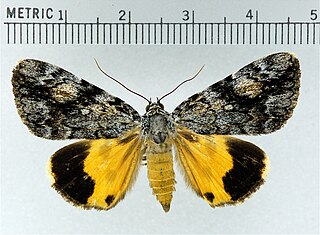
Catocala amica, the girlfriend underwing, is a moth of the family Erebidae. The species was first described by Jacob Hübner in 1818. It is found from southern Canada through the United States east of the Rocky Mountains, ranging westward to Oklahoma and Arizona, northward to Minnesota and southwestward to Texas.
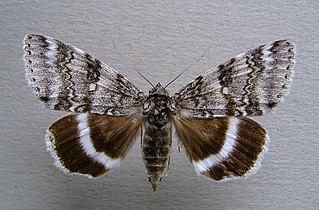
Catocala relicta, the white underwing or relict, is a moth of the family Erebidae. The species was first described by Francis Walker in 1858. It lives in southern Canada, from Newfoundland to Vancouver Island, south to Missouri, and Arizona.
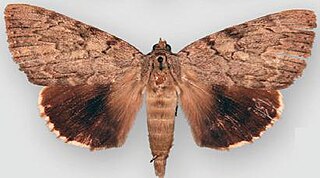
Catocala agrippina, the Agrippina underwing, is a moth of the family Erebidae. The species was first described by Herman Strecker in 1874. It is found in the United States from southern New Jersey south to Florida, west to Texas and eastern Oklahoma and north to southern Indiana.

Catocala dejecta, the dejected underwing, is a moth of the family Erebidae. It is found from Massachusetts and Connecticut south through New Jersey to Florida, west to Texas and Oklahoma and north to southern Ontario.

Catocala judith, or Judith's underwing, is a moth of the family Erebidae. The species was first described by Strecker in 1874. It is found in North America from southern Quebec and Ontario to the United States from New Hampshire south through Connecticut and New Jersey to North Carolina and Georgia, west to Oklahoma and Iowa and north to Wisconsin.

Catocala obscura, the obscure underwing, is a moth of the family Erebidae. The species was first described by Ferdinand Heinrich Hermann Strecker in 1873. In Canada it is found in southern Quebec and Ontario and in the United States it is found from Massachusetts and Connecticut south to North Carolina, west to Mississippi and north to Iowa, Illinois, Ohio, and Michigan.
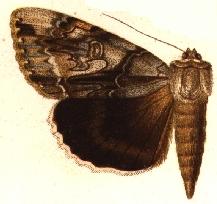
Catocala vidua, the widow underwing, is a moth of the family Erebidae. The species was first described by James Edward Smith in 1797. It is found in North America from southern Ontario, into Maine, New Hampshire and Connecticut, south at least to Tennessee, Georgia and Alabama, west to Texas and Oklahoma, and north to Wisconsin.

Catocala badia, the bay underwing, bayberry underwing or old maid, is a moth of the family Erebidae. It is found from southern Maine and New Hampshire south to New York and Connecticut.

Catocala delilah, the Delilah underwing, is a moth in the family Erebidae. The species was first described by Strecker in 1874. It is found in the southern and midwestern United States, from Ohio south to Florida and west to Texas and Oklahoma.

Catocala desdemona, the Desdemona underwing, is a moth of the family Erebidae. The species was first described by Henry Edwards in 1882. It is found in Utah and Arizona, ranging south into New Mexico and Texas, and onwards through Mexico up to Honduras.
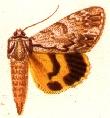
Catocala gracilis, the graceful underwing, is a moth of the family Erebidae. The species was first described by William Henry Edwards in 1864. It is found in North America from Manitoba to Nova Scotia and Maine, south through Connecticut, New Jersey to Florida and west to Mississippi and Missouri.

Catocala crataegi, the hawthorn underwing or chokeberry underwing, is a moth of the family Erebidae. It is found from Ontario and Quebec to Prince Edward Island south from Maine through Connecticut to Georgia and west to Arkansas and north to Minnesota.

Catocala pretiosa, the precious underwing, is a moth of the family Erebidae. The species was first described by Joseph Albert Lintner in 1876. It was included in Catocala crataegi by many authors, but recently it has been revalidated as a distinct species. The subspecies of pretiosa is listed as a species of special concern and believed extirpated in the US state of Connecticut.

Catocala andromache, the Andromache underwing, is a moth of the family Erebidae. The species was first described by Henry Edwards in 1885. It is found in the United States from southern California to Arizona.

Catocala micronympha, the little nymph underwing or little bride underwing, is a moth of the family Erebidae. The species was first described by Achille Guenée in 1852. It is found in North America from southern Ontario, Quebec, and Manitoba through New Hampshire, Connecticut, and New Jersey to Florida, west to Texas and then north through Oklahoma, Kansas, Iowa, to Wisconsin and Minnesota and then east to Michigan.

Catocala similis, the similar underwing, is a moth of the family Erebidae. The species was first described by William Henry Edwards in 1864. It is found in North America from Ontario and Quebec south through Maine and Connecticut to Florida, west to Texas and Oklahoma, and north to Minnesota.
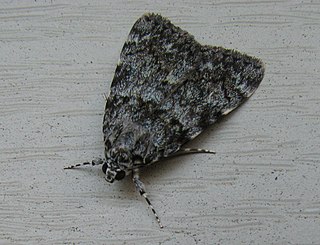
Catocala lineella, the lineella underwing, little lined underwing or steely underwing, is a moth of the family Erebidae. The species was first described by Augustus Radcliffe Grote in 1872. It is found in North America from Ontario and Quebec south to Florida west to Texas and north to Ohio.

Catocala jair, the Jair underwing or Barrens underwing, is a moth of the family Erebidae. The species was first described by Strecker in 1897. It is found from the Pine Barrens of New Jersey, in the coastal plain in Bladen County, North Carolina and in the northern half of Florida.















